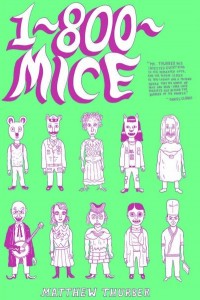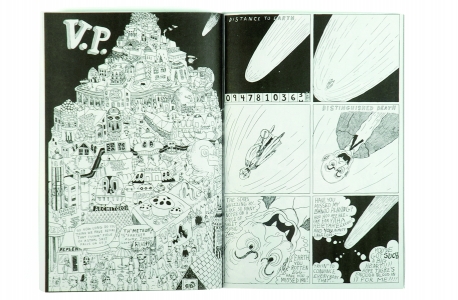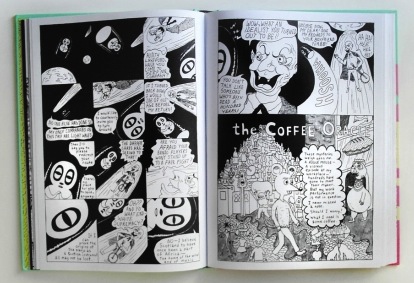 1-800-MICE
1-800-MICE
by Matthew Thurber
PictureBox, 2011
176 pages / Buy from PictureBox
There isn’t much crossover between the worlds of experimental comics and small press literature—perhaps some of us literary folk even harbor an unconscious prejudice of the comics form, writing it off as a lowbrow and degraded medium particular to a certain class of socially inept nerds (as if writers possess any kind of social grace…). If we adhere to these arbitrarily demarcated disciplinary boundaries, we will totally miss out on some mind-blowing gems out there, like Matthew Thurber’s hallucinatory and brain-bending epic 1-800-MICE. (Watch the trailer here.)
I picked Matthew’s 1-800-MICE up off my bedroom floor. It was sitting on top of a padded orange envelope that was addressed to my partner, who is a friend of Matthew’s. On the back of the envelope were a few whacky drawings done by Matthew himself. Pursuing the front and back cover of this beautiful book, I was impressed by the blurbs—Matt Groening (“Simpsons” creator?!), Daniel Clowes (Ghost World!?), and Ben Katchor (not sure who he is, by my partner assures me he is a “big deal”). Katchor proclaims that Thurber has “single-handedly revived the Surrealist program of revolutionary politics through dreamwork,” and the description compares the book to such giants as Pynchon and Tolkien. Though I had met the Brooklyn-based comics artist and musician many times before, I was totally unprepared for the genius contained within the pages of his book. One evening when my roommate was playing videogames I sat down on a couch with the book in my lap and read it cover-to-cover, giggling and making my roommate pause his game to read the funny parts.
As one of those literary-minded people, I was immediately struck by the brilliance of Matthew’s writing—the scope of his references, the bizarre witticisms and coded social commentaries, his competence at pulling off the vernacular speech associated with a range of times and places, and his ability to create a specific logic to govern the demented universe of his troubled characters. His intricate psychedelic drawings—the distinct characters and fantastic dwellings and landscapes he creates—also imbues the narrative with life, animating the story in a way that would impossible to achieve by text alone. In other words, Matthew is mindblowingly talented at both drawing and writing—though I really shouldn’t have been surprised. Matthew’s musical/performance project Ambergris also possesses a very “literary” quality. Not too long before I read Matthew’s book, my friend Jimmy (who came through my town while touring with his band Skeleton Warrior), was talking about how he was obsessed with watching videos of Ambergris performances on youtube, and how he was particularly impressed by Matthew’s lyrics, especially since it’s so rare to find a “noise music” act with such clever and sophisticated use of language (it’s usually just, like, fart sounds into a microphone or something).
1-800-MICE was initially released as a series of 5 issues (plus 1 unpublished) that were either self-published or released by the indie comics publisher Picturebox (though Matthew always intended to release it as one long book). The characters in 1-800-MICE are numerous. In true Pynchonian style, they emerge and vanish intermittently, each one bringing the argot of a particular subculture or occupation (Matthew even includes an index of characters in the beginning of the book). The cast of characters includes: Peace Punk, a genderqueer punk rock mouse; Doctor Vial, an egomaniacal dentist who, echoing Bataille, leads a an underground erotic death cult that lures people in with a nihilist pamphlet, titled The Decision of Self Removal; Groomsfield, a humble and obsequious mouse employed by the message delivery service 1-800-MICE; a police officer and his repressed doppelganger, who appear as two characters representing the trope of the good cop/bad cop as a sort of split personality type; a trio of power-hungry banjo shogunates/sibling rivals who eventually decide to settle their differences in a banjo duel that is also meant to resolve the “ethnomusicological question of the origin of this grand instrument;” a girl who is half-tree, half-human…and many more. The settings are numerous, too. I was really surprised when Loch Lomond was mentioned, as I happened to climb a mountain range overlooking the loch while I was staying in Scotland for a couple months.
A conspiratorial atmosphere permeates the narrative of 1-800-MICE—the plot is propelled by mysterious forces that reveal themselves in glimpses, leaving the reader hungry for the revelatory moment when all the disparate threads will cohere. In the book there are layers upon layers of overlapping absurdist conflicts and dramas—not so dissimilar to the structure of soap operas, though considerably more nightmarish and deranged. While the book is essentially a work of fantasy, beneath the surface it expresses a deep and a neurotic sense of metaphysical unease about many of the issues of our times—the internet, the war between humans and nature, drug culture, alienated labor, multiculturalism, etc. But given the nonsensical nature of the book, these latent commentaries aren’t exactly obvious or easy to resolve; perhaps the whole book even begs to be mulled over indefinitely.
Tags: 1-800-MICE, comics, Matthew Thurber, PictureBox




does anyone in the small press scene actually look down on indie comics? not sure i buy that
i have a couple of these & saw matthew’s band play in 2007, great to see he’s still at it!
have you heard of rory hayes? he’s sort of the godfather of this stuff. i have all three issues of bogeyman http://www.youtube.com/watch?v=K7Sxj0c3WnQ
i don’t think anyone actively looks down on them, but there seems to be very little discussion of them outside of chris higgs’s & a.d. jamesons superhero posts, or discussions of terrible stupid shit like The Watchmans.
i mean, tons of comix come out every year, and how many comics make “people in the small press scene’s” year end lists?
i definitely see what you mean, i agree wholeheartedly with the first part of the first sentence of the review, but just because it’s not talked about here/elsewhere, that doesn’t mean we all think it sux. i WISH there was a higher rate of crossover and collaboration between small press writers / cartoonists. i was talking with a friend after leaving that first comment in the thread, i wonder how much of this lack has to do with perceptions one group has of the other, despite the people within them being pretty much the exact same kinds of people
This looks great Jackie./Johannes
tinyurl.com/can5hdg
goo.gl/tX8v0
tinyurl.com/can5hdg
The introductory paragraph/review premise makes the reviewer in my honest not trying to be a dick opinion seem woefully out of touch or like he’s dealing with some sort of class/culture torment himself. Like, a: this isn’t the NY Times, baby boomers aren’t your reading demographic, and b: like, really? McSweeney’s did that comics hardcover during the BUSH-era. I mean, C.F., Aidan Koch, Blaise Larmee, Sara Drake, etc etc. IDK. Comics have never been nonliterary but they definitely aren’t now and haven’t been for so long, since RAW? I mean Mouly art directs the New Yorker…
I apologize for pronouning, assuming gender – true and 1-800-Mice reference.
[…] HTML Giant on 1-800-MICE. […]